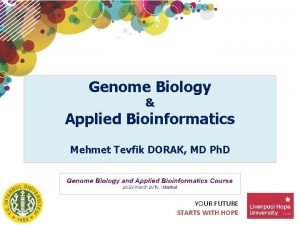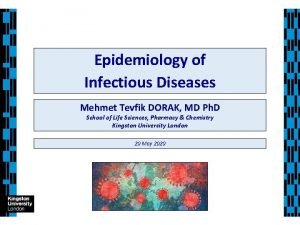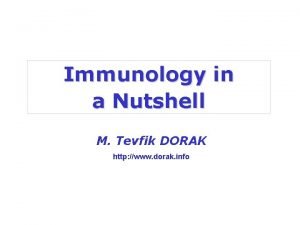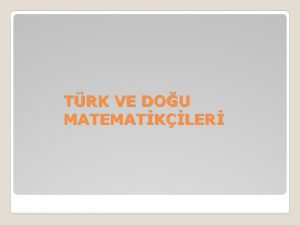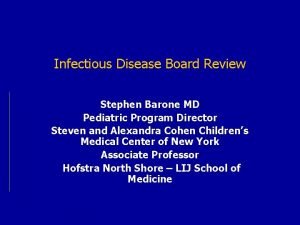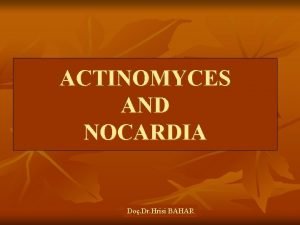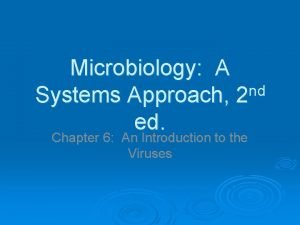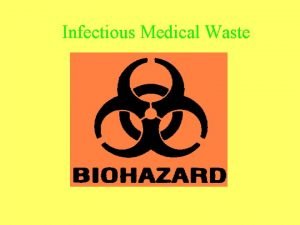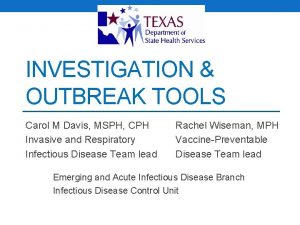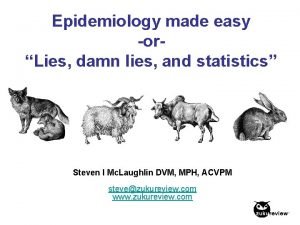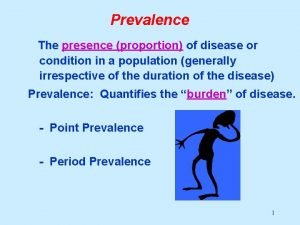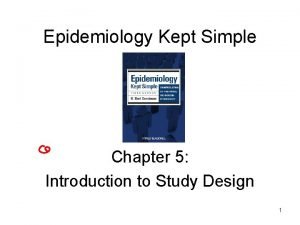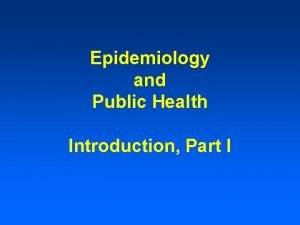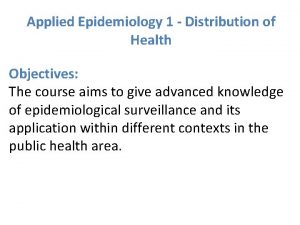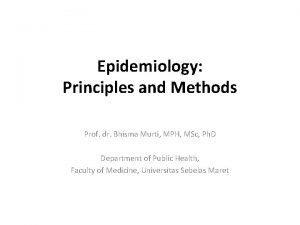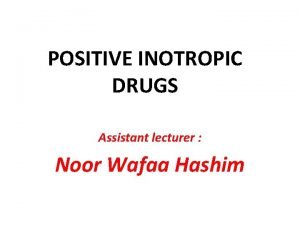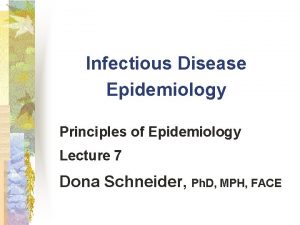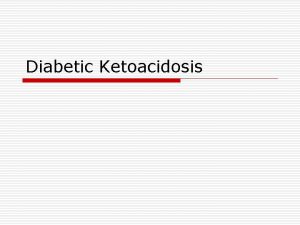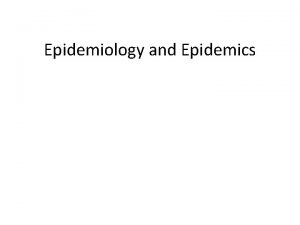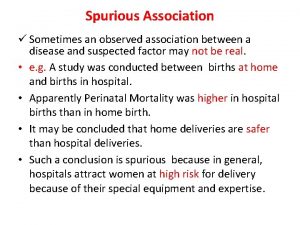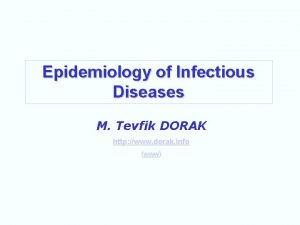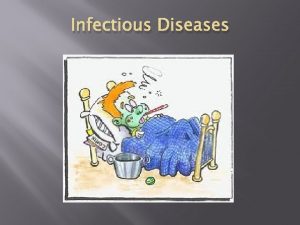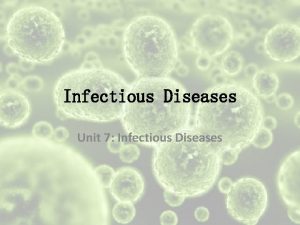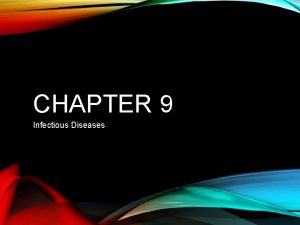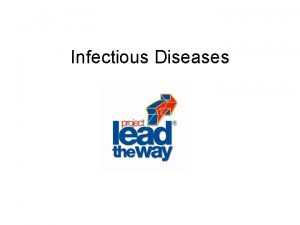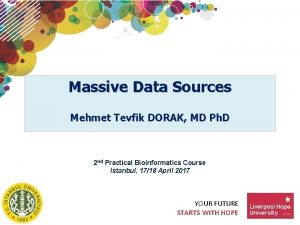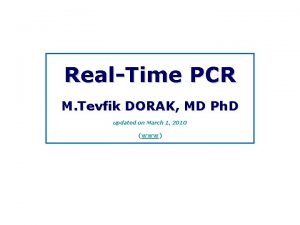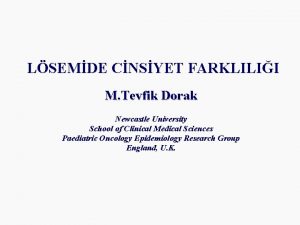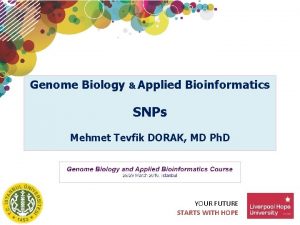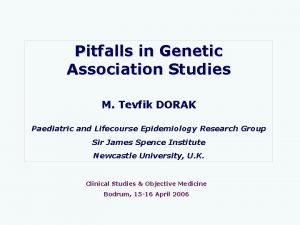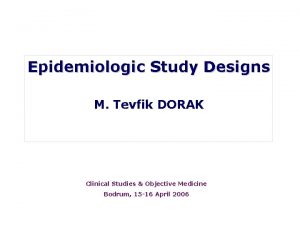Epidemiology of Infectious Diseases M Tevfik DORAK http


















































- Slides: 50

Epidemiology of Infectious Diseases M. Tevfik DORAK http: //www. dorak. info (www)

Infectious Disease Epidemiology: Major Differences • • • A case can also be an exposure Subclinical infections influence epidemiology Contact patterns play major role Immunity There is sometimes a need for urgency (www)

What is infectious disease epidemiology? Epidemiology • Deals with one population • Risk case • Identifies causes Infectious disease epidemiology v Two or more populations v A case is a risk factor v The cause often known (www)

What is infectious disease epidemiology? Two or more populations v. Humans v. Infectious agents v. Helminths, bacteria, fungi, protozoa, viruses, prions v. Vectors v. Mosquito (protozoa-malaria), snails (helminthsschistosomiasis) v. Blackfly (microfilaria-onchocerciasis) – bacteria? v. Animals v. Dogs and sheep/goats – Echinococcus v. Mice and ticks – Borrelia (www)

What is infectious disease epidemiology? A case is a risk factor … v. Infection in one person can be transmitted to others (www)

What is infectious disease epidemiology? The cause often known v An infectious agent is a necessary cause What is infectious disease epidemiology used for? v Identification of causes of new, emerging infections, e. g. HIV, v. CJD, SARS v Surveillence of infectious disease v Identification of source of outbreaks v Studies of routes of transmission and natural history of infections v Identification of new interventions (www)

Concepts Specific to Infectious Disease Epidemiology Attack rate, immunity, vector, transmission, carrier, subclinical disease, serial interval, index case, source, exposure, reservoir, incubation period, colonization, generations, susceptible, non-specific immunity, clone, resistance, repeat episodes …


Infectious Disease Definitions v Infectious diseases Tetanus Measles v. CJD v Caused by an infectious agent v Communicable diseases v Transmission – directly or indirectly – from an infected person v Transmissible diseases v Transmission – through unnatural routes – from an infected person Note v Infections are often subclinical – infections vs infectious diseases! v Antonyms not well-defined v Non-communicable diseases – virus involved in pathogenesis of diabetes? v Chronic diseases – HIV? (www)

Routes of transmission Direct Indirect v Skin-skin v Herpes type 1 v Mucous-mucous v Food-borne v STI v Across placenta v toxoplasmosis v Through breast milk v HIV v Salmonella v Water-borne v Hepatitis A v Vector-borne v Malaria v Air-borne v Chickenpox v Sneeze-cough v Influenza Exposure v A relevant contact – depends on the agent v. Skin, sexual intercourse, water contact, etc (www)

(www)

Some Pathogens that Cross the Placenta

Modes of Disease Transmission

Exposure to Infectious Agents No infection Death Clinical Carrier Sub-clinical Immunity Carrier No immunity Outcome (www)

Dynamics of infectiousness Susceptible Infection Timeline for Infection Latent period Infectious period Non-infectious Dynamics of disease Susceptible Infection Time Incubation period Symptomatic period Non-diseased Time (www)

Transmission Cases v Index – the first case identified v Primary – the case that brings the infection into a population v Secondary – infected by a primary case v Tertiary – infected by a secondary case T S Susceptible Immune Sub-clinical P S S T Clinical (www)

Person-to-Person Transmission Data from Dr. Simpson’s studies in England (1952) Measles Chickenpox Rubella Children exposed Children ill 251 201 238 172 218 82 attack rate 0. 80 0. 72 0. 38 Attack rate = ill exposed (www)

Epidemiologic Triad Disease is the result of forces within a dynamic system consisting of: agent of infection host environment

Factors Influencing Disease Transmission Agent Environment • Infectivity • Weather • Pathogenicity • Housing • Virulence • Geography • Immunogenicity • Occupational setting • Antigenic stability • Air quality • Survival • Food • Age • Sex Host • Genotype • Behaviour • Nutritional status • Health status (www)

Epidemiologic Triad-Related Concepts Infectivity (ability to infect) (number infected / number susceptible) x 100 Pathogenicity (ability to cause disease) (number with clinical disease / number infected) x 100 Virulence (ability to cause death) (number of deaths / number with disease) x 100 All are dependent on host factors

Predisposition to Infections (Host Factors) Gender Genetics Climate and Weather Nutrition, Stress, Sleep Smoking Stomach Acidity Hygiene


Chain of Infection Horton & Parker: Informed Infection Control Practice (www)

Infection Cycle of Schistosomiasis Peters: Tropical Medicine and Parasitology, 2001 (www)

Infection Cycle of Leishmaniasis Lipoldova & Demand, 2006 (www)

Iceberg Concept of Infection

Infectious Agents Bacteria Viruses Fungi Protoctists / Protozoa Helminths Algae Prions (proteinaceous infectious agents)

Phylogenetic Classification of Bacteria Oxford Textbook of Medicine

Phylogenetic Classification of Viruses Oxford Textbook of Medicine

Prions (PRI-ons: proteinaceous infectious agents) Mabbott & Mac. Pherson, Nat Rev Microbiol 2006 (www)

Reservoirs A host that carries a pathogen without injury to itself and serves as a source of infection for other host organisms (asymptomatic infective carriers) (www)

Reservoirs Humans {hepatitis} Other Vertebrates {zoonoses} Birds & Bats {histoplasmosis} NOT vectors

Vectors A host that carries a pathogen without injury to itself and spreads the pathogen to susceptible organisms (asymptomatic carriers of pathogens)

Vectors Other parasites have life cycles that involve intermediate organisms, or vectors, which carry disease -causing microorganisms from one host to another. The protozoan blood parasite that causes sleeping sickness, or trypanosomiasis, infects humans, cattle, and other animals. It uses the tsetse fly as a vector to carry it from one host to the next. When a tsetse fly bites an infected animal, it picks up the parasite when it sucks blood. When an infected fly bites another animal, the parasite enters the bloodstream and begins to reproduce in the new host.

Arthropod Vectors Pathogen - Vector Viruses (Arbovirus) - Mosquitoes Bacteria (Yersinia) - Fleas Bacteria (Borrelia) - Ticks Rickettsias (R. prowazeki) - Lice, ticks Protozoa (Plasmodium) - Mosquitoes Protozoa (Trypanozoma) -Tsetse flies Helminths (Onchocerca) - Simulium flies

Koch’s Postulates The same organism is present in every case It is isolated or grown in pure culture The disease can be reproduced in healthy animals after infection with pure culture The identical pathogen is reisolated from the experimental animals

Koch’s Postulates

Ecological Factors in Infections Altered environment {Air conditioning} Changes in food production & handling {intensive husbandry with antibiotic protection; deep-freeze; fast food industry} Climate changes {Global warming} Deforestation Ownership of (exotic) pets Air travel & Exotic journeys / Global movements Increased use of immunosuppressives/ antibiotics American Museum of Natural History Exhibition: Epidemic! The World of Infectious Disease (www)

Infectious Disease Process Direct tissue invasion Toxins Persistent or latent infection Altered susceptibility to drugs Immune suppression Immune activation (cytokine storm)

Mathematical Modelling in Infectious Disease Epidemiology

Reproductive Number, R 0 A measure of the potential for transmission The basic reproductive number, R 0, the mean number of individuals directly infected by an infectious case through the total infectious period, when introduced to a susceptible population probability of transmission per contact R 0 = p • c • d duration of infectiousness contacts per unit time Infection will …. . disappear, if become endemic, if become epidemic, if R<1 R=1 R>1 (www)

Reproductive Number, R 0 • Useful summary statistic • Definition: the average number of secondary cases a typical infectious individual will cause in a completely susceptible population • Measure of the intrinsic potential for an infectious agent to spread (www)

Reproductive Number, R 0 • If R 0 < 1 then infection cannot invade a population – implications: infection control mechanisms unnecessary (therefore not cost-effective) • If R 0 > 1 then (on average) the pathogen will invade that population – implications: control measure necessary to prevent (delay) an epidemic

Reproductive Number, R 0 Use in STI Control R 0 = p • c • d p c condoms, acyclovir, zidovudine D case ascertainment (screening, partner notification), treatment, compliance, health seeking behaviour, accessibility of services health education, negotiating skills (www)

What determines R 0 ? p, transmission probability per exposure – depends on the infection v HIV, p(hand shake)=0, p(transfusion)=1, p(sex)=0. 001 v interventions often aim at reducing p v use gloves, screene blood, condoms c, number of contacts per time unit – relevant contact depends on infection v same room, within sneezing distance, skin contact, v interventions often aim at reducing c v Isolation, sexual abstinence d, duration of infectious period v may be reduced by medical interventions (TB, but not salmonella) (www)

Immunity – herd immunity v. If R 0 is the mean number of secondary cases in a susceptible population, then R is the mean number of secondary cases in a population where a proportion, p, are immune R = R 0 – (p • R 0) v. What proportion needs to be immune to prevent epidemics? If R 0 is 2, then R < 1 if the proportion of immune, p, is > 0. 50 If R 0 is 4, then R < 1 if the proportion of immune, p, is > 0. 75 v. If the mean number of secondary cases should be < 1, then R 0 – (p • R 0) < 1 p > (R 0 – 1)/ R 0 = 1 – 1/ R 0 v If R 0 =15, how large will p need to be to avoid an epidemic? p > 1 -1/15 = 0. 94 v. The higher R 0, the higher proportion of immune required for herd immunity (www)

Endemic - Epidemic - Pandemic Cases R>1 R=1 R<1 Time v Endemic v Transmission occur, but the number of cases remains constant v Epidemic v The number of cases increases v Pandemic v When epidemics occur at several continents – global epidemic (www)

Number of Cases of a Disease Endemic vs Epidemic Endemic Time Epidemic

Levels of Disease Occurrence Sporadic level: occasional cases occurring at irregular intervals Endemic level: persistent occurrence with a low to moderate level Hyperendemic level: persistently high level of occurrence Epidemic or outbreak: occurrence clearly in excess of the expected level for a given time period Pandemic: epidemic spread over several countries or continents, affecting a large number of people (www)

http: //www. dorak. info
 Mehmet tevfik dorak
Mehmet tevfik dorak Mehmet tevfik dorak
Mehmet tevfik dorak Tevfik dorak
Tevfik dorak Icd 10 morbus hansen
Icd 10 morbus hansen Epidemiological triad
Epidemiological triad Dorak
Dorak Kerim erim
Kerim erim Hüseyin tevfik paşa
Hüseyin tevfik paşa Infectious canine hepatitis in dogs
Infectious canine hepatitis in dogs University of washington
University of washington Stages of infection
Stages of infection Poisonous and infectious material symbol
Poisonous and infectious material symbol Smallest infectious agent
Smallest infectious agent Stridor
Stridor Infectious disease
Infectious disease Chapter 26 infectious disease prevention and control
Chapter 26 infectious disease prevention and control Quizlet
Quizlet Infectious canine hepatitis in dogs
Infectious canine hepatitis in dogs Infectious waste management
Infectious waste management Infectious mononucleosis
Infectious mononucleosis Stages of infectious disease
Stages of infectious disease Infectious stunting syndrome
Infectious stunting syndrome Infectious nucleic acid
Infectious nucleic acid Infectious disease quality controls
Infectious disease quality controls Hennepin county infectious disease manual
Hennepin county infectious disease manual Endemic definition in community health nursing
Endemic definition in community health nursing Field epidemiology ppt
Field epidemiology ppt Pros and cons of cross sectional study
Pros and cons of cross sectional study Orlies
Orlies Ukuran asosiasi epidemiologi
Ukuran asosiasi epidemiologi Prevalensi adalah
Prevalensi adalah Epidemiology kept simple
Epidemiology kept simple Biological plausibility
Biological plausibility Classification of epidemiological studies
Classification of epidemiological studies Descriptive epidemiology
Descriptive epidemiology Define epidemiology
Define epidemiology Distribution in epidemiology
Distribution in epidemiology What is descriptive study in epidemiology
What is descriptive study in epidemiology Bhisma murti
Bhisma murti Example of recall bias
Example of recall bias Advantages and disadvantages of nutritional epidemiology
Advantages and disadvantages of nutritional epidemiology How dr. wafaa elsadr epidemiology professor
How dr. wafaa elsadr epidemiology professor Attack rate
Attack rate Diabetic ketoacidosis epidemiology
Diabetic ketoacidosis epidemiology Prevalence defination
Prevalence defination Descriptive vs analytical epidemiology
Descriptive vs analytical epidemiology Epidemiological triad
Epidemiological triad Ramboman analysis
Ramboman analysis Spurious association
Spurious association Certification board of infection control and epidemiology
Certification board of infection control and epidemiology Attack rate epidemiology formula
Attack rate epidemiology formula
